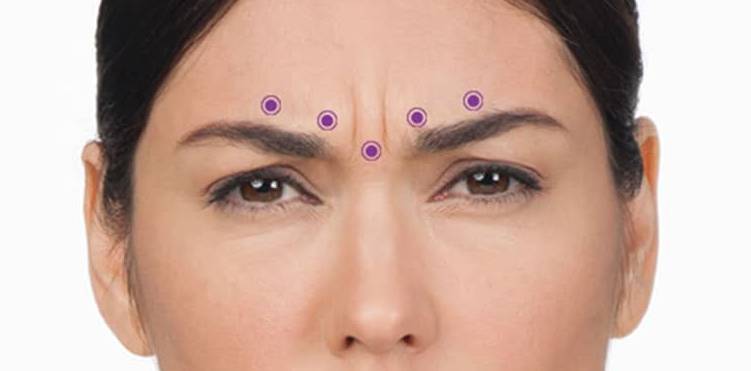Botox treatment for Glabellar Lines - Dr Yeung Ho Hong 楊浩康

How Botox Can Improve Frown Lines and Wrinkles Between the Brows
Glabellar lines and frown lines are common concerns for many individuals seeking aesthetic improvements. These wrinkles are primarily caused by the prolonged contraction of muscles between the eyebrows. The main muscles influencing wrinkle formation in this area include the 皺眉肌 (corrugator muscle), 鼻眉肌 (procerus muscle), and 降眉肌 (depressor supercilii muscle). These muscles frequently work together during facial expressions, instantly creating looks of caution, sadness, or determination. Over time, dynamic wrinkles leave lasting marks on the forehead and between the eyebrows.
Botulinum toxin injection, as a non-surgical cosmetic procedure, aims to reduce wrinkles caused by repeated muscle contractions by locally relaxing the aforementioned muscles. Before treatment, a professional physician conducts a detailed consultation with the patient, assessing facial muscle activity, wrinkle depth, and facial structure to ensure the injection plan is reasonable and aligns with aesthetic principles. In most cases, doctors select three precise injection points in the glabellar region to effectively target the primary wrinkle-causing areas. However, if a patient’s 皺眉肌 (corrugator muscle) is particularly strong or well-developed, the number of injection points may increase to five for a more balanced and natural outcome.
During the procedure, accurately determining the injection sites and dosage is critical. Overdosing or imprecise injection placement can lead to side effects, such as drooping of the upper eyelid, which may diminish the expressiveness of the eyes. Additionally, post-injection, the eyebrows may unnaturally elevate, or facial asymmetry may occur. While these potential risks are not inevitable, they underscore the need for physicians with extensive clinical experience and profound anatomical knowledge to minimize complications while ensuring aesthetic results.
Prior to treatment, physicians typically perform a comprehensive facial evaluation, closely observing the patient’s dynamic expressions and static wrinkle patterns. Experienced doctors often combine visual assessment with digital simulation technology to precisely mark each injection point, ensuring the toxin effectively targets the intended muscles. Some patients may also have close-up facial photos taken before treatment as a baseline for comparing pre- and post-treatment results, providing a clear visual representation of the improvements achieved through botulinum toxin injection.
During the procedure, the physician first thoroughly cleans and disinfects the skin, applying a small amount of local anesthetic to minimize discomfort during injection. The entire process typically takes only a few minutes, requiring no hospitalization or general anesthesia risks. Most patients experience a brief recovery period post-treatment and can resume daily activities shortly after. The effects of the injection usually become noticeable within a few days, reaching their peak approximately one to two weeks later.
Post-treatment care is equally vital for achieving optimal results. Physicians carefully instruct patients to avoid touching or massaging the injection sites for at least four hours after treatment to prevent the toxin from spreading to unintended muscles. During this period, patients should also avoid high-temperature environments, intense exercise, or excessive fatigue, as these factors could affect the toxin’s distribution and final outcome. Some professional clinics provide ice packs to alleviate potential localized swelling or minor bruising post-injection.
Although botulinum toxin injection techniques are well-established, the final outcome still depends on each patient’s individual condition. For individuals with higher muscle tension or unique facial structures, physicians may adjust the dosage or number of injection points to achieve the best anti-wrinkle effect. Effective communication between the patient and physician is crucial throughout this process. Only by fully understanding the patient’s expectations and needs can a treatment plan be tailored to their specific characteristics.
Furthermore, regular maintenance treatments are key to achieving long-term improvement. As the effects of botulinum toxin gradually wear off over time, most patients require follow-up injections every three to four months. This not only consistently controls wrinkles but also allows for adjustments to the injection strategy based on changes in facial muscles, resulting in a sustained and natural effect. Some patients opt to combine botulinum toxin injections with other minimally invasive procedures (e.g., dermal fillers or laser resurfacing) to comprehensively enhance overall facial youthfulness.
In summary, botulinum toxin injection offers significant benefits for improving glabellar lines and frown lines. By precisely controlling injection points and dosage, it not only alleviates deep wrinkles caused by prolonged muscle contraction but also softens and naturalizes facial contours. With ongoing technological advancements and increasing clinical expertise, this treatment continues to be a preferred solution for many seeking facial rejuvenation.
